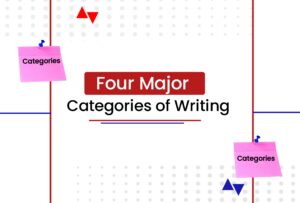Est. reading time: 2 minutes

One of the easiest ways to write better is to determine what you intend to achieve with that content. Understanding the four major categories of writing will help you determine where your intended content falls and, consequently, the purpose of such content.
Follow me, let’s take a short walk through the four major categories of writing.
Major Categories of Writing
Expository Writing
Expository writing aims to inform and explain without personal bias. It presents facts, data, and concepts objectively.
Examples:
- Textbooks: provide factual information on various subjects.
- Journalism (excluding opinion pieces): news articles, reports, and features.
- Business Writing: memos, reports, and manuals.
- Technical Writing: instructions, user guides, and scientific papers.
This category of writing would require the writer to cover the major points or categories of the topic he or she intends to write about. For instance, a journalist covering an accident scene would need to write about how the accident occurred and the aftermaths: injured persons, survivors, deceased persons, and the like.
Descriptive Writing
Descriptive writing paints vivid pictures using sensory details. It appeals to our senses and emotions.
Examples:
- Fiction: novels, short stories, and poetry.
- Advertising: captivating product descriptions.
- Journal/Diary Writing: personal reflections.
This category of writing requires the writer to be familiar with various choices of words to convey feelings, expressions, and precision. Novelists, storywriters, and poets are usually masters of this category of writing; this category of writing requires them to give vivid descriptions that would evoke an imaginary perception of the described scenario in the minds of the readers.
Persuasive Writing
Persuasive writing aims to sway opinions or encourage action. It’s about convincing the reader.
Examples:
- Advertisements: persuading consumers to buy a product.
- Opinion Articles: editorials, blog posts, and columns.
- Speeches: influential speakers advocating for change.
- Marketing content: promoting a cause or brand.
Copywriters must be familiar with this category of writing. This aspect of writing is for the purpose of promoting a particular concept, product or idea to specific or general readers. It includes articles or content that highlights the benefits of adopting such a concept, product, or idea.
This category of writing is also relevant in the marketing industry, as it helps marketers sell their products to potential customers. An instance of marketing in this context is a seller appealing to you to buy his or her product, just like the Kianco appealing to you to buy its book (Home).
Narrative Writing
Narrative writing tells stories. It has characters, a plot, and a setting.
Examples:
- Novels: engaging tales that transport readers to different worlds.
- Short Stories: bite-sized narratives with impactful messages.
- Memoirs: personal accounts of life experiences.
- Personal Narratives: Reflecting on pivotal moments.
From the name of the category, it won’t be hard to tell that this category is about telling stories, and events or passing a message from a specific perspective. This category of writing is not so different from descriptive writing, as the two categories require the usage of words that convey feelings, expression, and precision, just like I said earlier.
Conclusion
Understanding the major categories of writing will help you determine the purpose of what you intend to write and will also guide your choice of words and the structure of your content.

